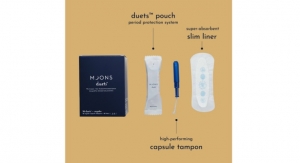Gil Stevens, Sustainability and External Affairs Director, EDANA10.08.18
We have all seen the pictures: filthy plastic webs swimming the Pacific Ocean in five giant ocean gyres, turtles doing the tango with shopping bags, rivers choked with cheap, disposable single use goods. Although plastic was discovered in the last century, only recently have serious attempts been made at estimating the amount of plastic in the oceans and the impact on the seas—and ultimately human life. The ocean garbage patches are estimated to already contain more than 150 million tons of plastic with 4.6 to 12.7 million tons added each year.
We appear to have reached a tipping point. As the European Commission states “marine litter can cause serious economic damage: Potential cost across EU for coastal and beach cleaning was assessed at almost €630 million per year. Taking into account its accumulation and dissemination, marine litter may be one of the fastest growing threats to the health of the world’s oceans.”
To address this the Commission recently proposed several legislative pieces, aiming to drive the EU economy to a circular future, avoiding the outflow of valuable plastics and mitigating environmental impact. The EU Strategy for Plastics in the Circular Economy includes measures to transform the way plastics and plastic products are designed, produced, used and recycled. It also sets new targets in municipal waste recycling, from 44% today to 65% by 2035 and to reduce landfilling to no more than 10% by 2035.
The strategy, a non-binding draft resolution recently adopted by the EU Parliament, sets out to ban micro-plastics in cosmetics and oxo-degradable plastics, set quality standards for recycled plastics and to reduce litter. Environment commissioner Karmenu Vella calls it “the jewel in our circular economy crown.” Although EU legislators acknowledge that Europe is a relatively small contributor to marine litter, the hope is to send a positive message to international partners that success is there to be shared. A peer-reviewed study revealed that just 10 rivers transport 88% to 95% of the global plastic load into the marine environment. Eight of those rivers are situated in Asia, with The Yangtze being the biggest culprit. The remaining two (the Nile and the Niger) are found in Africa.
The directive on the reduction of the impact of certain plastic products on the environment, better known as the ‘Single-Use Plastics Directive’ is the most recent proposal from the Commission, concretizing the ambitions on the reduction of marine litter. Based on a list of the 10 most common plastic objects found on beaches (which together constitute 70% of all marine litter items), and fishing gear containing plastic, the Commission has written a proposal with a range of policy measures; from bans and reduction targets, to Extended Producer Responsibility (EPR) schemes, whereby producers contribute to clean up costs and consumer awareness campaigns. The nonwoven goods in scope are wet wipes and feminine hygiene products.
Where Will This Lead?
The directive raises several questions:
What is plastic?
The EU Commission makes a valiant effort in defining plastic in the Single-Use Plastics directive. Although everyone has a certain idea of plastic, it turns out to be difficult in practice to agree on a concise definition, especially given the intention of the Commission to include polymers that may originate from renewable sources, but do not degrade in a marine environment.
This leads to the second question: what is marine degradation?
Test methods for determining aerobic biodegradation of plastic materials in the marine are standardized by ASTM. However, there are no ISO equivalents to this standard. And even within this standard it is admitted that caution needs to be exercised when extrapolating results.
The absence of a standard for European marine degradation might have triggered the EU parliament to strongly support the Commission in setting EU-wide standards and definitions on biodegradability and compostability.
Consumer Behavior is Key
Regarding wet wipes, our industry has been working on guidelines for over a decade to fine-tune design and composition to ensure the rapid breakdown needed to flush these products. Coupled with an industry code of practice stipulating clear labelling on flushability, the industry has demonstrated initiative in responsible product stewardship for some time. These measures now look likely to be superseded by regulations however.
What can be expected?
While the single-use plastics directive winds its way through the legislative process, members of the European Parliament see this directive as a key opportunity for action before the end of term next May. With those elections in mind, dozens of amendments have been tabled that include widening the scope to include labelling requirements on substances of high concern, reduced consumption targets for wipes and extended producer responsibilities for diapers and feminine hygiene products.
Although difficult to predict what the outcome of the legislative procedure will be, the intention is clear. Hugo Schally, DG environment, explains, “Plastics have a place in our society, but we should tackle some of the environmental issues, arising with the use thereof, so that we can ensure plastics retain their place in society.”
As an industry we have always been focused on the full life cycle assessment of our products. Our many LCA analyses demonstrate significant environmental progress over the last year for diapers, wipes and other nonwoven products, while focusing on the biggest environmental impacts, such as resource efficiency and carbon footprint. However, these recent legislative proposals push us to face the fact that we must never lose sight of the environmental issues to which consumers and other stakeholders attach the most importance to today: littering and specifically marine litter and the need for recycling.
We are encouraged by the innovations within our industry. Many of the industry players are looking into the fate of products at the end of the life cycle and starting research, pilot projects and new business models to provide answers. Several of our members now market new products that use innovative renewable and biodegradable materials.
The role of the industry is therefore to stay open to such societal demands, to evolve and heed the arguments being made. Producers will need to focus not only on the overall environmental impact, but also address the specific impacts, either by being more transparent or by innovating solutions. Only such responsible product stewardship will ensure our products continue to meet consumer requirements while also mitigating their impact.
Sustainable business practices and the regulatory challenges facing the nonwovens sector will be discussed in depth at OUTLOOK 2018, the world’s premier nonwovens personal care and hygiene products conference. For more information please visit www.edana.org
We appear to have reached a tipping point. As the European Commission states “marine litter can cause serious economic damage: Potential cost across EU for coastal and beach cleaning was assessed at almost €630 million per year. Taking into account its accumulation and dissemination, marine litter may be one of the fastest growing threats to the health of the world’s oceans.”
To address this the Commission recently proposed several legislative pieces, aiming to drive the EU economy to a circular future, avoiding the outflow of valuable plastics and mitigating environmental impact. The EU Strategy for Plastics in the Circular Economy includes measures to transform the way plastics and plastic products are designed, produced, used and recycled. It also sets new targets in municipal waste recycling, from 44% today to 65% by 2035 and to reduce landfilling to no more than 10% by 2035.
The strategy, a non-binding draft resolution recently adopted by the EU Parliament, sets out to ban micro-plastics in cosmetics and oxo-degradable plastics, set quality standards for recycled plastics and to reduce litter. Environment commissioner Karmenu Vella calls it “the jewel in our circular economy crown.” Although EU legislators acknowledge that Europe is a relatively small contributor to marine litter, the hope is to send a positive message to international partners that success is there to be shared. A peer-reviewed study revealed that just 10 rivers transport 88% to 95% of the global plastic load into the marine environment. Eight of those rivers are situated in Asia, with The Yangtze being the biggest culprit. The remaining two (the Nile and the Niger) are found in Africa.
The directive on the reduction of the impact of certain plastic products on the environment, better known as the ‘Single-Use Plastics Directive’ is the most recent proposal from the Commission, concretizing the ambitions on the reduction of marine litter. Based on a list of the 10 most common plastic objects found on beaches (which together constitute 70% of all marine litter items), and fishing gear containing plastic, the Commission has written a proposal with a range of policy measures; from bans and reduction targets, to Extended Producer Responsibility (EPR) schemes, whereby producers contribute to clean up costs and consumer awareness campaigns. The nonwoven goods in scope are wet wipes and feminine hygiene products.
Where Will This Lead?
The directive raises several questions:
What is plastic?
The EU Commission makes a valiant effort in defining plastic in the Single-Use Plastics directive. Although everyone has a certain idea of plastic, it turns out to be difficult in practice to agree on a concise definition, especially given the intention of the Commission to include polymers that may originate from renewable sources, but do not degrade in a marine environment.
This leads to the second question: what is marine degradation?
Test methods for determining aerobic biodegradation of plastic materials in the marine are standardized by ASTM. However, there are no ISO equivalents to this standard. And even within this standard it is admitted that caution needs to be exercised when extrapolating results.
The absence of a standard for European marine degradation might have triggered the EU parliament to strongly support the Commission in setting EU-wide standards and definitions on biodegradability and compostability.
Consumer Behavior is Key
Regarding wet wipes, our industry has been working on guidelines for over a decade to fine-tune design and composition to ensure the rapid breakdown needed to flush these products. Coupled with an industry code of practice stipulating clear labelling on flushability, the industry has demonstrated initiative in responsible product stewardship for some time. These measures now look likely to be superseded by regulations however.
What can be expected?
While the single-use plastics directive winds its way through the legislative process, members of the European Parliament see this directive as a key opportunity for action before the end of term next May. With those elections in mind, dozens of amendments have been tabled that include widening the scope to include labelling requirements on substances of high concern, reduced consumption targets for wipes and extended producer responsibilities for diapers and feminine hygiene products.
Although difficult to predict what the outcome of the legislative procedure will be, the intention is clear. Hugo Schally, DG environment, explains, “Plastics have a place in our society, but we should tackle some of the environmental issues, arising with the use thereof, so that we can ensure plastics retain their place in society.”
As an industry we have always been focused on the full life cycle assessment of our products. Our many LCA analyses demonstrate significant environmental progress over the last year for diapers, wipes and other nonwoven products, while focusing on the biggest environmental impacts, such as resource efficiency and carbon footprint. However, these recent legislative proposals push us to face the fact that we must never lose sight of the environmental issues to which consumers and other stakeholders attach the most importance to today: littering and specifically marine litter and the need for recycling.
We are encouraged by the innovations within our industry. Many of the industry players are looking into the fate of products at the end of the life cycle and starting research, pilot projects and new business models to provide answers. Several of our members now market new products that use innovative renewable and biodegradable materials.
The role of the industry is therefore to stay open to such societal demands, to evolve and heed the arguments being made. Producers will need to focus not only on the overall environmental impact, but also address the specific impacts, either by being more transparent or by innovating solutions. Only such responsible product stewardship will ensure our products continue to meet consumer requirements while also mitigating their impact.
Sustainable business practices and the regulatory challenges facing the nonwovens sector will be discussed in depth at OUTLOOK 2018, the world’s premier nonwovens personal care and hygiene products conference. For more information please visit www.edana.org










